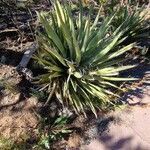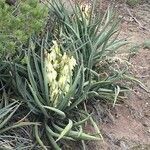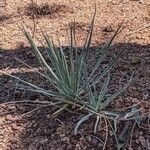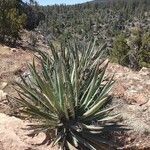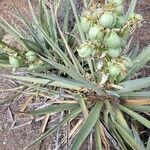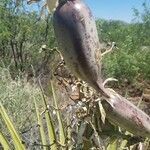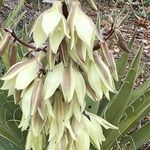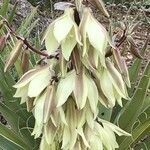Plants often forming open colonies of rosettes, acaulescent or short-caulescent, shorter than 2.5 m. Stems, if present, decumbent, 1–24, aerial or subterranean, simple or sometimes branched, to 2 m. Leaf blade erect, bluish green, concavo-convex, 30–100 × 2–6 cm, rigid, scabrous or glaucous, margins brown. Inflorescences erect, paniculate, dense, arising completely within to mostly extending beyond rosettes, ovoid, 6–8.2 dm, glabrous, rarely slightly pubescent; peduncle scapelike, to 0.8 m. Flowers pendent, 5–13 cm, nearly as wide; perianth campanulate; tepals connate basally to form shallow floral cup 7–12 mm, usually cream-colored, occasionally tinged with purple, 4.5–13 cm; filaments connate proximally into collarlike structure, 3.2–12 mm, fleshy, pubescent; anthers 5–7 mm; pistil 4.5–8 × 0.7–1.2 cm (usually 4–5(–7) times longer than broad); ovary 0.7–1.2 cm; style 5–7 mm; stigmas distinct. Fruits pendent, baccate, indehiscent, elongate, 5–23 × 4–7.5 cm, fleshy, succulent. Seeds dull black, obovate, 7–11 mm diam., 3 mm thick, rugose.
More
A shrub. It grows 1.5 m high and spreads 1.2 m wide. It can have a single stem or the trunk can be branched. The old leaves remain on the stem. The leaves are green with yellow or blue tinges. There are fine hairs on the edges of the leaves. The flowers are bell shaped. They occur in panicles. They are cream and tinged with purple. The fruit is the size of a large fig.
The young flower buds are roasted. The fruit is eaten raw. They are also dried and stored. They are also used in pies. The seeds can be roasted and used for flour. This can be used to thicken soups and stews. They can also be used for a drink. The flower stalks can be boiled for 20-30 minutes and eaten as a vegetable.
